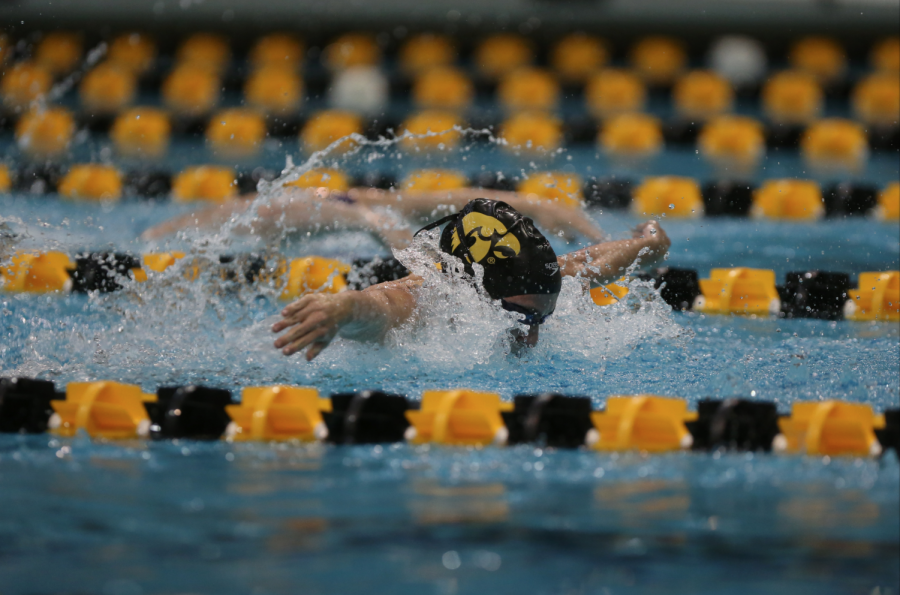The University of Iowa: Birthplace of the butterfly stroke
In the early 1930s, a University of Iowa swimming coach helped developed what is known as the butterfly stroke.
Iowa’s Meghan Hackett swims in the Women’s 100-meter fly during the Iowa-Northwestern meet at the Campus Recreation and Wellness Center on Saturday, Jan. 21, 2017. Hackett finished in first with a time of 57.47. The Hawkeyes defeated the Wildcats, 156-144.
October 11, 2018
The University of Iowa is the birthplace of the butterfly — the butterfly stroke that is.
The swimming stroke was not exactly invented at Iowa, but it was certainly perfected in Iowa City in the early 1930s. The butterfly technique started to develop as people were looking for a more efficient way to do the breaststroke.
“We are all proud that is something we can hold to our program,” Iowa head coach Marc Long said. “I know it is something we certainly started to embrace when we built this pool, even with the bronze statue. I think if you are a butterflier here, it gives it a big special meaning.”
David Armbruster, a former Iowa swimming coach, was interested on how to fix the problem of drag because of the underwater recovery in the breaststroke. Armbruster realized in 1934 that bringing the arms forward over the water in a breaststroke was more efficient. He would later call this style the butterfly.
A year later, Armbruster worked with one of his swimmers, Jack Sieg, to develop a kicking technique that uses the legs in unison. The style is now known as the dolphin fishtail kick.
The swimmer and coach quickly realized by combining these two techniques, it created a very fast swimming style. Currently, both styles used together is now known as the butterfly.
RELATED: Iowa swimming and diving tops Michigan State before Intrasquad
The new style of swimming was faster than the regular breaststroke, and people quickly switched. The move was illegal for more than a decade, because the dolphin fishtail kick violated the breaststroke rules set by the International Swimming Federation.
Many swimmers worked around this rule by using the butterfly arms with breaststroke kick. The swimmers who did this competed in breaststroke competitions, because the style was a variant of the stroke. The butterfly was finally recognized as its own style with its own set of rules in 1952.
The history of the butterfly is evident, and the history in the program helps with recruiting.
“It is something we show, and now we still show if we can, the old Field House pool,” Long said. “It is still up and running for another year or so, we hope. That thing oozes history, and it’s just fun to be a part of that. We try selling it with the university, and that is certainly a big discovery and development that happened at our school.”
The history wasn’t the main reason women’s swimmer Kelsey Drake came to Iowa, saying she loved the way she bonded with the team on her recruiting visit, but it didn’t hurt.
“Well I am a butterflier, and coming here is kind of special since it was invented here,” Drake said. “It just makes it a little extra special and fun coming here.”
Now long after the stroke has been in play, the Hawkeyes started the season with a 1-0 record on both the men’s and women’s side with wins over Michigan State on Sept. 28.
The women will be back in action this weekend against SMU, starting Friday, while the men have some time, competing next against Minnesota on Oct. 27.






